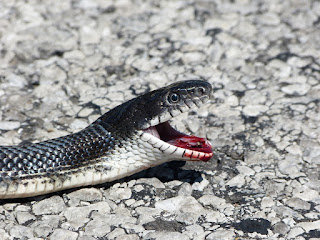Gray Ratsnakes are extremely rare in Southern Ontario, with very few individuals remaining, Surviving snakes are probably in several isolated populations making the situation even more dire. To say the population is critically endangered would be accurate. This is in contrast to the ratsnake population (special concern ranking) that occurs in the Kingston area/Frontenac Axis that is faring much better.
Not all is doom and gloom however. Several organisations work locally that will benefit this species. Nature Conservancy Canada (NCC) has recently protected thousands of acres of land in the area, working to connect forest blocks by retiring and restoring agricultural lands. The Long Point Basin Land Trust (LPBLT) also acquires and protects ecologically significant lands while also running a Carolinian Reptiles Project. Volunteers are encouraged to submit sightings, do road surveys, and partake in stewardship of their lands. The land trust also installs hibernacula and predator-proof snake nesting structures on secure properties. Hopefully this will keep more snakes off of roads! LPBLT' is my current employer and the website is here: http://www.longpointlandtrust.ca/
This roadkill Gray Ratsnake certainly looks alive, but it's not. You can see some blood in the below photo.
While the black and white colouration of this snake is distinct, Norfolk also has some very large, all black Hog-nosed Snakes, as well as black gartersnakes that get mistaken for this species. As you can see from the photo ratsnakes have a blunt nose as opposed to an upturned "hog-nose". Black (melanistic) gartersnakes don't reach this size, and juvenile ratsnakes are blotchy patterned.
I added the lens cap for a sense of scale, but perhaps I should start carrying a ruler.
Notice the blotchy belly pattern. The pattern is unique between individuals and can be used to tell one snake from another.
Even in large ratsnakes you can usually make out a faint blotchy pattern held over from younger days. Note also the smooth scales with no or little keel (ridge) down the middle. Gartersnakes have well keeled scales. Interestingly, the skin between scales appears orange in some spots and I've heard that about some ratsnakes down here. I wonder how that compares to the other Ontario population. Anybody know?
Time for a happy photo. One of ten Northern Map Turtles on the Grand River between Paris and Brantford this past Friday.






I wish I could share a picture I took today. Everyone says it's a "rat-snake" - which I agree - but the patern and color are most similar to this specimen shown in your photograph. It is close to 7' long.
ReplyDelete